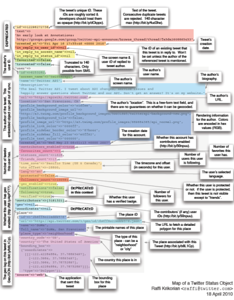This spring at Twitter’s first developer conference Chirp the big splash was a forthcoming feature called Annotations. The feature will allow publishing software to annotate Tweets with a wide open variety of metadata, which could then be read and analyzed by other software. Annotations are going to be big, if and when they launch.

At Chirp it was said that the Annotations feature would launch in the second or third quarter of this year. Now the company’s developer advocate, Taylor Singletary, said today on the Twitter developers list that it’s not going to work out that way. “We haven’t yet announced a release date,” he said in response to an inquiry, “and it’s still a ways in the future while we tackle some other projects.”
We’ve got an inquiry in with Twitter asking what that means, but it seems clear that the company is slammed with technical challenges, has other priorities and wrongly estimated the roadmap for this very important part of the platform. (Update: see below.)
Here’s how Annotations will work. It will allow publishing software to mark-up tweets with any kind of characteristic or namespace (local weather when and where a twit did tweet, for example) and any kind of value – cloudy with a chance of meatballs, for example. Twitter messages are fairly rich with metadata already and incredibly easy to analyze and build on top of, but Annotations would open that up so far the sky’s the limit.
It’s worth mentioning that Twitter’s unveiling of Annotations at Chirp happened around the same time as, and was widely compared with, Facebook’s launching of personalized content widgets and tentacles expanding all over the web, among other things. Facebook shipped its announced project, for better or for worse.
Twitter is Busy
In another email on the same list today, Singletary said that the processing of white-listing applications to ping Twitter’s servers with a production-level frequency was clogged with backlog, growing more critical in its evaluations and being re-evaluated.
A whole world of independent developers, empowered with the ability to read and write data, will inevitably build cooler things than even the smartest company in the world.
It’s one of those laws like a room full of monkeys and typewriters. And it’s the core value proposition of Annotations, too.
Meanwhile, Twitter launched an official recommendation feature today that’s frankly, not nearly as exciting as the kinds of recommendation capabilities that independent developers have built (see
or
, for example). Hopefully the API for this feature will be turned into more fabulous things. A whole world of independent developers, empowered with the ability to read and write data, will inevitably build cooler things than even the smartest company in the world. It’s one of those laws like a room full of monkeys and typewriters. And it’s the core value proposition of Annotations, too.
Numerous advertising technologies have been rolled out since Chirp as well. Annotations is a hugely ambitious strategy, and the squabbling over namespaces and standards was one that Twitter said it was going to let the market work out on its own. That made some people quite unhappy.
We’ve asked Twitter for clarification on the revised Annotations roadmap and will update this post with the company’s response.
Update: A Twitter spokesperson responded to our inquiry and said that yes, Annotations will launch. “We’ll still launch Annotations. The team that was working on Annotations is currently focused on our number one priority, which is site stability.” No doubt Annotations could themselves pose scalability challenges. They could at least blow our minds, if not a series of related servers.
Below is an image of what each Tweet looks like under the hood right now, before annotations. (Click for full size view.) Each of those fields is powerful, but inflexible and defined by the company. Imagine a new one that’s open to being defined however a publishing tool sees fit. That’s the vision behind Annotations.











